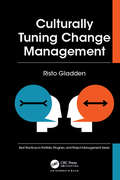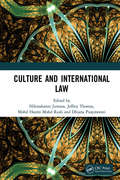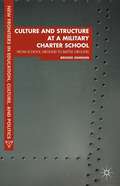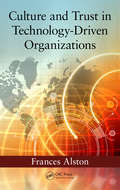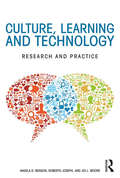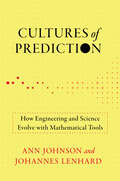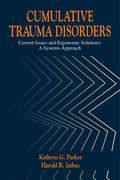- Table View
- List View
Cultural Understanding of Soils: The importance of cultural diversity and of the inner world
by Christian Feller Sabine Grunwald Eric C. Brevik Nikola PatzelCultural understandings of soil are diverse and often ambiguous. Cultural framing of soils is common worldwide and is highly consequential. The implications of what place the earth has in people's world view and everyday life can be in line with or in conflict with natural conditions, with scientific views, or with agricultural practices. The main assumption underlying this work is that soil is inescapably perceived in a cultural context by any human. This gives emergence to different significant webs of meaning influenced by religious, spiritual, or secular myths, and by a wide range of beliefs, values and ideas that people hold in all societies. These patterns and their dynamics inform the human-soil relationship and how soils are cared for, protected, or degraded.Therefore, there is need to deal inter-culturally with different sources and types of knowledge and experience regarding soil; a need to cultivate soil awareness and situationally appropriate care through inter- and intra-cultural dialogues and learning. This project focuses on the human and intangible dimensions of soil.To serve this aim, the International Union of Soil Sciences (IUSS) founded a working group on Cultural Patterns of Soil Understanding that has resulted in this book, which presents studies from almost all continents, written by soil scientists and experts from other disciplines. A major objective of this project is to promote intercultural literacy that gives readers the opportunity to appreciate soil across disciplinary and cultural boundaries in an increasingly globalized world. . .
Cultural Urban Heritage: Development, Learning and Landscape Strategies (The Urban Book Series)
by Mladen Obad Šćitaroci Bojana Bojanić Obad Šćitaroci Ana MrđaThis book presents strategies and models for cultural heritage enhancement from a multidisciplinary perspective. It discusses identifying historical, current and possible future models for the revival and enhancement of cultural heritage, taking into consideration three factors – respect for the inherited, contemporary and sustainable future development. The goal of the research is to contribute to the enhancement of past cultural heritage renovation and enhancement methods, improve the methods of spatial protection of heritage and contribute to the development of the local community through the use of cultural, and in particular, architectural heritage. Cultural heritage is perceived primarily through conservation, but that comes with limitations. If heritage is perceived and experienced solely through conservation, it becomes a static object. It needs to be made an active subject, which implies life in heritage as well as new purposes and new life for abandoned heritage. Heritage can be considered as a resource that generates revenue for itself and for the sustainability of the local community. To achieve this, it should be developed in accordance with contemporary needs and technological achievements, but on scientifically based and professional criteria and on sustainable models. The research presented in this book is based on the approach of Heritage Urbanism in a combination of experiments (case studies) and theory.
Culturally Inclusive Instructional Design: A Framework and Guide to Building Online Wisdom Communities
by Casey Frechette Charlotte Gunawardena Ludmila LayneWINNER OF THE 2019 OUTSTANDING BOOK AWARD FROM AECT'S DIVISION OF DISTANCE EDUCATION! As online courses and digital learning enable more people from more places to learn together, it is crucial for instructional design to incorporate diverse cultural perspectives. Culturally Inclusive Instructional Design provides a framework for thinking about culture in digital learning, offering insight into how to build inclusive online communities that encourage reflection and growth, regardless of content domain. Chapters cover the foundation, components, and implementation of the authors’ Wisdom Communities (WisCom) framework, which enables learners from global backgrounds to experience long-lasting, transformative learning through real-world problem-solving. This book is a timely, resourceful guide to building truly collaborative, inquiry-based online learning experiences.
Culturally Responsive Science Pedagogy in Asia: Status and Challenges for Malaysia, Indonesia and Japan (Routledge Series on Schools and Schooling in Asia)
by Lilia Halim Murni Ramli Mohd Norawi AliScience learning, for many, is often seen as learning a culture of science knowledge and practices - that is incongruent from one’s everyday experiences and cultural background of learners. This edited volume presents a systemic view of the current initiatives and challenges for the inclusion of Culturally Responsive Science Pedagogy (CRSP) in non-western and multicultural contexts in three Asian countries – Malaysia, Indonesia and Japan. Split into three parts, the book examines the history and current educational systems, curriculums, and socio-cultural diversities in each country, offering an updated review of equity in education. It reflects and expands on the role of CSRP in diverse societies, before going into case studies that feature the experiences of teachers in implementing CRSP in Malaysia, Indonesia and Japan. These snapshots reflect the multiple ways equity is addressed in the teaching and learning of science in Asian countries, allowing readers to extrapolate the possible challenges and best practices for designing and implementing CRSP in practice. The final section examines how these findings provide a sustainable platform for building capacity in understanding of the cultural complexities and realities of recruiting and retaining diverse students into science. One of few books to investigate the role of CRSP in diverse societies in Malaysia, Indonesia and Japan, this book makes a unique contribution to the field of science education with reference to culturally responsive pedagogy. Its strategies and solutions serve as an important comprehensive reference for researchers and science teacher educators.
Culturally Tuning Change Management (Best Practices in Portfolio, Program, and Project Management)
by Risto GladdenManaging change across cultures can be tricky, and universal approaches to change management may not serve their purpose in every cultural setting. This book examines the cultural dimensions that can influence the perceptions of and reactions to change in different cultural contexts and highlights the benefits of developing and applying cultural mindfulness when planning and running cross-cultural change initiatives. It offers practical advice to project and change management teams and leaders for developing Cultural Intelligence, tailoring plans to consider any cultural variables that could be barriers to (or catalysts for) effective change, and applying facilitating strategies.
Culture Clash: Law and Science in America
by Steven GoldbergIt is an article of faith in America that scientific advances will lead to wondrous progress in our daily lives. Americans proudly support scientific research that yields stunning breakthroughs and Nobel prizes. We relish the ensuing debate about the implications—moral, ethical, practical—of these advances. Will genetic engineering change our basic nature? Will artificial intelligence challenge our sense of human uniqueness? And yet the actual implementation of these technologies is often sluggish and much-delayed. From Star Trek to Jurassic Park, the American imagination has always been fascinated by the power of scientific technology. But what does the reality of scientific progress mean for our society? In this controversial book, Steven Goldberg provides a compelling look at the intersection of two of America's most powerful communities—law and science—to explain this apparent contradiction. Rarely considered in tandem, law and science highlight a fundamental paradox in the American character, the struggle between progress and process. Science, with its ethic of endless progress, has long fit beautifully with America's self image. Law, in accordance with the American ideal of giving everyone a fair say, stresses process above all else, seeking an acceptable, rather than a scientifically correct, result. This characteristic has been especially influential in light of the explosive growth of the legal community in recent years. Exposing how the legal system both supports and restricts American science and technology, Goldberg considers the role and future of three projects—artificial intelligence, nuclear fusion, and the human genome initiative—to argue for a scientific vision that infuses research with social goals beyond the pure search for truth. Certain to provoke debate within a wide range of academic and professional communities, Culture Clash reveals one of the most important and defining conflicts in contemporary American life.
Culture Clash: Law and Science in America (Open Access Lib And Hc Ser.)
by Steven GoldbergIt is an article of faith in America that scientific advances will lead to wondrous progress in our daily lives. Americans proudly support scientific research that yields stunning breakthroughs and Nobel prizes. We relish the ensuing debate about the implications—moral, ethical, practical—of these advances. Will genetic engineering change our basic nature? Will artificial intelligence challenge our sense of human uniqueness? And yet the actual implementation of these technologies is often sluggish and much-delayed. From Star Trek to Jurassic Park, the American imagination has always been fascinated by the power of scientific technology. But what does the reality of scientific progress mean for our society? In this controversial book, Steven Goldberg provides a compelling look at the intersection of two of America's most powerful communities—law and science—to explain this apparent contradiction. Rarely considered in tandem, law and science highlight a fundamental paradox in the American character, the struggle between progress and process. Science, with its ethic of endless progress, has long fit beautifully with America's self image. Law, in accordance with the American ideal of giving everyone a fair say, stresses process above all else, seeking an acceptable, rather than a scientifically correct, result. This characteristic has been especially influential in light of the explosive growth of the legal community in recent years. Exposing how the legal system both supports and restricts American science and technology, Goldberg considers the role and future of three projects—artificial intelligence, nuclear fusion, and the human genome initiative—to argue for a scientific vision that infuses research with social goals beyond the pure search for truth. Certain to provoke debate within a wide range of academic and professional communities, Culture Clash reveals one of the most important and defining conflicts in contemporary American life.
Culture and Human-Robot Interaction in Militarized Spaces: A War Story (Emerging Technologies, Ethics and International Affairs)
by Julie CarpenterExplosive Ordnance Disposal (EOD) personnel are some of the most highly trained people in the military, with a job description that spans defusing unexploded ordnance to protecting VIP’s and state dignitaries. EOD are also one of the first military groups to work with robots every day. These robots have become an increasingly important tool in EOD work, enabling people to work at safer distances in many dangerous situations. Based on exploratory research investigating interactions between EOD personnel and the robots they use, this study richly describes the nuances of these reciprocal influences, especially those related to operator emotion associated with the robots. In particular, this book examines the activities, processes and contexts that influence or constrain everyday EOD human-robot interactions, what human factors are shaping the (robotic) technology and how people and culture are being changed by using it. The findings from this research have implications for future personnel training, and the refinement of robot design considerations for many fields that rely on critical small group communication and decision-making skills.
Culture and International Law: Proceedings of the International Conference of the Centre for International Law Studies (CILS 2018), October 2-3, 2018, Malang, Indonesia
by Hikmahanto Juwana Jeffrey Thomas Mohd Hazmi Mohd Rusli Dhiana PuspitawatiIn this era of globalization, International Law plays a significant role in facing rapid development of various legal issues. Cultural preservation has emerged as an important legal issue that should be considered by States. This book consists of academic papers presented and discussed during the 9th International Conference of the Centre of International Law Studies (9th CILS Conference) held in Malang, Indonesia, 2-3 October 2018. The title of the book represents the major theme of the conference: "Culture and International Law." It is argued that along with globalization, cultural preservation is slowly ignored by States. Various papers presented in the book cover five topics: cultural heritage; cultural rights; culture and economic activity; culture and armed conflict; and a general topic. The authors of the papers are outstanding academics from various countries, Lithuania, United States of America, Australia, Thailand and Indonesia.The conference was organized by Universitas Indonesia in collaboration with Brawijaya University. This book aims to give a useful contribution to the existing literature on International Law, specifically focussing on cultural issues from the perspective of cultural heritage and rights, economic as well as armed conflict.
Culture and Structure at a Military Charter School
by Brooke JohnsonTaking military charter schools as her subject, and drawing on years of research at one school in particular, Brooke Johnson explores the underpinings of a culture based on militarization and neoliberal educational reforms and probes its effects on individual identity and social interactions at the school.
Culture and Trust in Technology-Driven Organizations
by Frances AlstonThis book provides insight into the important role that culture and trust can play in the success of high-technology organizations. There has been little research to demonstrate a connection between organizational culture and trust. This book introduces a review of the literature and the result of an empirical study that investigated the relationship between mechanistic and organic cultures and the level of trust in technology-based organizations.
Culture and Utilization of Live Food Organisms for Aquahatcheries
by Jham Lal Sahil H. S. MogalekarIn today's world, food scarcity and food security are significant global concerns, with 811 million people suffering from hunger and 3 billion individuals unable to afford healthy diets. This book discusses fisheries and aquaculture as crucial contributors to nutritional security and the need for sustainable practices to meet the growing demand. The subject matter of this book covers: Recycling of Waste Through Tubifex Culture and Used as Live Food in Aquahatcheries Culture Techniques of Daphnia Mosquito Larval Control Through the Larvivorous Fish Chlorella Live Food: Cultivation and Applications Print edition not for sale in South Asia (India, Sri Lanka, Nepal, Bangladesh, Pakistan and Bhutan)
Culture by Design: Practical Strategies for Wellbeing, Engagement and Growth
by Hugo MetcalfeCulture by Design is about shifting focus from solely organisational outcomes and performance, towards organisational culture and wellbeing. It bridges the gap between two key organisational goals: (a) the drive for improving performance, outcomes and staff retention, and (b) strategies to encourage employee wellbeing, motivation and engagement within the workplace. For too long, organisations have focussed on each of these goals individually, with improvements in one area often coming at the expense of the other. This book demonstrates that this does not need to be the case, that what is required is a shift in perspective towards a culture-focussed approach where improved outcomes, performance and engagement are the added bonuses of a happy, connected staff team. You may be familiar with the phrase "Happy bees work harder"; this book demonstrates the fundamental truth in that statement and illustrates that "What is good for the bees is good for the hive".Through practical strategies and real-world examples, this book reveals that the application of evidence-led, self-directed and cost-effective strategies can support any organisation to cultivate the culture they need to encourage the outcomes they want. This book offers a synthesis of theory and practice from organisational and social psychology, neuroscience and systems dynamics, alongside examples of practical tools you can start using today, to offer a roadmap to cultivating a workplace culture that supports the wellbeing and performance of the organisation as a whole.Whether you are an HR director, People Manager, C-Suite Team member or Wellbeing and Culture Lead, this book is relevant to Leaders in organisations of any size. If you are interested in what works when it comes to improving staff wellbeing, how to go about the process of culture change or who makes the tea and why it matters, then this book is for you.
Culture in International Construction
by Wilco Tijhuis Richard FellowsDespite the wide range of technologies involved, the construction industry still relies heavily on one old-fashioned component: the human. The clients, managers, designers, investors, and a whole host of other stakeholders are all involved in a crucial series of relationships that are just as important to project success as technical know-how. As construction projects become increasingly international as well as interdisciplinary, the risk and cost of disharmonious working grows ever larger. The growth of IT and the increased reliance on large mergers and joint-ventures have created new problems, which require a new set of solutions. Recent research has generated profound insights into international differences in business culture. This new work presents up-to-date theory and practical guidance, identifying situations in which cultural differences present challenges. A focus on "critical incidents", demonstrated in a range of case studies will help readers to foresee such situations in their own projects and processes, and so improve strategic and operational decision-making in construction collaborations. Detailed examples are taken from the Netherlands, Germany, Poland, Turkey, the UAE, and China, to explore a variety of problems in very different economic and cultural surroundings. A range of professionals (contractors, developers, investors, architects, engineers, governments, public/private clients) will find this book highly valuable, as will researchers and students.
Culture, Communication and National Identity: The Case of Canadian Television
by Richard Collins‘There can be no political sovereignty without culture sovereignty.’ So argued the CBC in 1985 in its evidence to the Caplan/Sauvageau Task Force on Broadcasting Policy. Richard Collins challenges this assumption. He argues in this study of nationalism and Canadian television policy that Canada’s political sovereignty depends much less on Canadian content in television than has generally been accepted. His analysis focuses on television drama, at the centre of television policy in the 1980s.Collins questions the conventional image of Canada as a weak national entity undermined by its population’s predilection for foreign television. Rather, he argues, Canada is held together, not by a shared repertoire of symbols, a national culture, but by other social forces, notably political institutions. Collins maintains that important advantages actually and potentially flow from Canada’s wear national symbolic culture. Rethinking the relationships between television and society in Canada may yield a more successful broadcasting policy, more popular television programming, and a better understanding of the links between culture and the body politic. As the European Community moves closer to political unity, the Canadian case may become more relevant to Europe, which, Collins suggests, already fears the ‘Canadianization’ of its television. He maintains that a European multilingual society, without a shared culture or common European audio-visual sphere and with viewers watching foreign television, can survive successfully as a political entity – just as Canada has.
Culture, Learning, and Technology: Research and Practice
by Angela D. Benson Roberto Joseph Joi L. MooreCulture, Learning, and Technology: Research and Practice provides readers with an overview of the research on culture, learning, and technology (CLT) and introduces the concept of culture-related theoretical frameworks. In 13 chapters, the book explores the theoretical and philosophical views of CLT, presents research studies that examine various aspects of CLT, and showcases projects that employ best practices in CLT. Written for researchers and students in the fields of Educational Technology, Instructional Design, and the Learning Sciences, this volume represents a broad conceptualization of CLT and encompasses a variety of settings. As the first significant collection of research in this emerging field of study, Culture, Learning, and Technology overflows with new insights into the increasing role of technology use across all levels of education.
Cultures in Human-Computer Interaction (Synthesis Lectures on Human-Centered Informatics)
by Sergio SayagoThis book provides an interdisciplinary synthesis of the topic of culture in the context of Human-Computer Interaction (HCI) and a structured overview of a large body of HCI research on (and with) culture. The book presents a short and guided overview of the concept of culture. It offers some background on the origin and development of the term culture. It also outlines some of its key traits and ingredients and summarizes three main perspectives of culture across disciplines. The book argues that culture matters considerably in HCI and discusses a number of reasons for and against its relevance. Arguments against include a lack of a universal or common definition of the term culture and globalization. Arguments in favor touch upon important aspects of HCI, including a diversely growing user base, the need to provide designers with enough support to design across cultures, and the inseparable relationship between culture and technology. The issues explored in this book can be classified into three, non-mutually exclusive, categories: theoretical, practical, and controversial. The book outlines the main conceptual perspectives of culture within HCI, including Geert Hofstede’s cultural dimensions theory, Edward T. Hall’s cross-cultural theory of communication, and Richard Nisbett’s cultural cognitive systems of thought as well as examining the ways in which culture has been operationalized in HCI research and the main functions of culture in this area. It closes with a discussion of some open issues intended to spark debate and future research. The literature this book draws upon covers a wide range of research disciplines, including Anthropology, Sociology, Cultural Studies, Robotics, Disability Studies, Cultural and Cross-Cultural Psychology, Usability, and Design. This book aspires to provide a useful overview of culture for HCI scholars at all levels.
Cultures in Orbit: Satellites and the Televisual
by Lisa Ann ParksIn 1957 Sputnik, the world's first man-made satellite, dazzled people as it zipped around the planet. By the beginning of the twenty-first century, more than eight thousand satellites orbited the Earth, and satellite practices such as live transmission, direct broadcasting, remote sensing, and astronomical observation had altered how we imagined ourselves in relation to others and our planet within the cosmos. In Cultures in Orbit, Lisa Parks analyzes these satellite practices and shows how they have affected meanings of "the global" and "the televisual." Parks suggests that the convergence of broadcast, satellite, and computer technologies necessitates an expanded definition of "television," one that encompasses practices of military monitoring and scientific observation as well as commercial entertainment and public broadcasting.Roaming across the disciplines of media studies, geography, and science and technology studies, Parks examines uses of satellites by broadcasters, military officials, archaeologists, and astronomers. She looks at Our World, a live intercontinental television program that reached five hundred million viewers in 1967, and Imparja tv, an Aboriginal satellite tv network in Australia. Turning to satellites' remote-sensing capabilities, she explores the U.S. military's production of satellite images of the war in Bosnia as well as archaeologists' use of satellites in the excavation of Cleopatra's palace in Alexandria, Egypt. Parks's reflections on how Western fantasies of control are implicated in the Hubble telescope's views of outer space point to a broader concern: that while satellite uses promise a "global village," they also cut and divide the planet in ways that extend the hegemony of the post-industrial West. In focusing on such contradictions, Parks highlights how satellites cross paths with cultural politics and social struggles.
Cultures of Milk
by Andrea S. WileyMilk is the only food mammals produce naturally to feed their offspring. The human species is the only one that takes milk from other animals and consumes it beyond weaning age. Cultures of Milk contrasts the practices of the world's two leading milk producers, India and the United States. In both countries, milk is considered to have special qualities. Drawing on ethnographic and scientific studies, popular media, and government reports, Andrea Wiley reveals that the cultural significance of milk goes well beyond its nutritive value. Shifting socioeconomic and political factors influence how people perceive the importance of milk and how much they consume. In India, where milk is out of reach for many, consumption is rising rapidly among the urban middle class. But milk drinking is declining in America, despite the strength of the dairy industry. Milk is bound up in discussions of food scarcity in India and food abundance in the United States. Promotion of milk as a means to enhance child growth boosted consumption in twentieth-century America and is currently doing the same in India, where average height is low. Wiley considers how variation among populations in the ability to digest lactose and ideas about how milk affects digestion influence the type of milk and milk products consumed. In India, most milk comes from buffalo, but cows have sacred status for Hindus. In the United States, cow's milk has long been a privileged food, but is now facing competition from plant-based milk.
Cultures of Prediction: How Engineering and Science Evolve with Mathematical Tools (Engineering Studies)
by Ann Johnson Johannes LenhardA probing examination of the dynamic history of predictive methods and values in science and engineering that helps us better understand today&’s cultures of prediction.The ability to make reliable predictions based on robust and replicable methods is a defining feature of the scientific endeavor, allowing engineers to determine whether a building will stand up or where a cannonball will strike. Cultures of Prediction, which bridges history and philosophy, uncovers the dynamic history of prediction in science and engineering over four centuries. Ann Johnson and Johannes Lenhard identify four different cultures, or modes, of prediction in the history of science and engineering: rational, empirical, iterative-numerical, and exploratory-iterative. They show how all four develop together and interact with one another while emphasizing that mathematization is not a single unitary process but one that has taken many forms.The story is not one of the triumph of abstract mathematics or technology but of how different modes of prediction, complementary concepts of mathematization, and technology coevolved, building what the authors call &“cultures of prediction.&” The first part of the book examines prediction from early modernity up to the computer age. The second part probes computer-related cultures of prediction, which focus on making things and testing their performance, often in computer simulations. This new orientation challenges basic tenets of the philosophy of science, in which scientific theories and models are predominantly seen as explanatory rather than predictive. It also influences the types of research projects that scientists and engineers undertake, as well as which ones receive support from funding agencies.
Cumulative Environmental Effects Of Oil And Gas Activities On Alaska's North Slope
by Committee on Cumulative Environmental Effects of Oil Gas Activities on Alaska's North SlopeThis book identifies accumulated environmental, social and economic effects of oil and gas leasing, exploration, and production on Alaska's North Slope. Economic benefits to the region have been accompanied by effects of the roads, infrastructure and activies of oil and gas production on the terrain, plants, animals and peoples of the North Slope. While attempts by the oil industry and regulatory agencies have reduced many of the environmental effects, they have not been eliminated. The book makes recommendations for further environmental research related to environmental effects.
Cumulative Trauma Disorders: Current Issues and Ergonomic Solutions
by Kathryn G. ParkerOSHA frequently requires companies to implement the type of program promoted in Cumulative Trauma Disorders, the first and only book to address both the medical and ergonomic aspects of cumulative trauma.
Cunning Machines: Your Pocket Guide to the World of Artificial Intelligence (Chapman & Hall/CRC Artificial Intelligence and Robotics Series)
by Jędrzej OsińskiThere are many myths and mistakes which make the topics of artificial intelligence complex and confusing. But the truth is that the foundations of AI are not rocket science. People do not need a PhD to understand how a basic neural network works. In fact, one does not even need computer skills to learn this. Cunning Machines: Your Pocket Guide to the World of Artificial Intelligence explains the main concepts: what does AI really mean, where do we find it, how do scientists try to evaluate it, what are its main limitations and what future we can expect with it? It also describes the most popular AI techniques in an easy-to-digest form: Artificial neural networks Genetic algorithms The Monte Carlo method Natural language processing Ontologies and their applications This book is for everyone. Still, it may be especially valuable to teachers who wish to enrich their classes with some interesting and popular topics, sales managers and business analysts who wish to better understand the IT world, and finally politicians and journalists who take part in debates on the latest technologies. Jędrzej Osiński earned a PhD in artificial intelligence, has worked on government grants and has published 14 scientific papers to date. He is also the co-author of two books. At the same time, he has over ten years of experience working in IT companies of different sizes, domains (the web, telecoms, banking, e-learning), organisation structures and locations (Poland, Ireland and the UK). He is also involved in various initiatives promoting AI, science and modern technologies including blog posts, invited talks and TV and radio appearances
Cupcake Fix: A Branches Book (Layla and the Bots #3)
by Vicky FangLayla and the Bots are building a SWEET new invention!Pick a book. Grow a Reader!This series is part of Scholastic's early chapter book line Branches, aimed at newly independent readers. With easy-to-read text, high-interest content, fast-paced plots, and illustrations on every page, these books will boost reading confidence and stamina. Branches books help readers grow!Blossom Valley is opening a new community center! But they need to generate buzz for the grand opening. Layla and the Bots know how to help: they will build a cupcake machine for the party! But will their invention be a piece of cake... or a recipe for disaster? With full-color artwork on every page, speech bubbles throughout, and a fun DIY activity that readers can try at home, this early chapter book series brings kid-friendly STEAM topics to young readers!
Curators: Behind the Scenes of Natural History Museums
by Lance GrandeOver the centuries, natural history museums have evolved from being little more than musty repositories of stuffed animals and pinned bugs, to being crucial generators of new scientific knowledge. They have also become vibrant educational centers, full of engaging exhibits that share those discoveries with students and an enthusiastic general public. At the heart of it all from the very start have been curators. Yet after three decades as a natural history curator, Lance Grande found that he still had to explain to people what he does. This book is the answer—and, oh, what an answer it is: lively, exciting, up-to-date, it offers a portrait of curators and their research like none we’ve seen, one that conveys the intellectual excitement and the educational and social value of curation. Grande uses the personal story of his own career—most of it spent at Chicago’s storied Field Museum—to structure his account as he explores the value of research and collections, the importance of public engagement, changing ecological and ethical considerations, and the impact of rapidly improving technology. Throughout, we are guided by Grande’s keen sense of mission, of a job where the why is always as important as the what. This beautifully written and richly illustrated book is a clear-eyed but loving account of natural history museums, their curators, and their ever-expanding roles in the twenty-first century.




